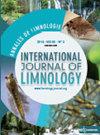Zooplankton species distribution, richness and composition across tropical shallow lakes: A large scale assessment by biome, lake origin, and lake habitat
IF 0.9
4区 环境科学与生态学
Q4 LIMNOLOGY
Annales De Limnologie-international Journal of Limnology
Pub Date : 2020-01-01
DOI:10.1051/limn/2020023
引用次数: 5
Abstract
Assessing zooplankton biodiversity is essential to support freshwater management/conservation programs. Here, we investigated the zooplankton community structure from 180 shallow lakes in northeastern Brazil and analyzed them according to biome (Atlantic Forest or Caatinga), the origin of ecosystems (natural or man-made lakes), and habitat type (pelagic or littoral). Additionally, we provided an updated list of zooplankton species. We registered 227 species (137 Rotifera, 65 Cladocera, 25 Copepoda). The most common species of each major group among all lakes were the cladoceran Ceriodaphina cornuta, the rotifers Brachionus havanaensis and Lecane bulla, and the copepod Termocyclops decipiens. Species related to aquatic vegetation, as the Lecanidae rotifers and phytophilous cladocerans, were more frequent along Atlantic Forest biome and natural lakes. On the other hand, species that are bioindicators of eutrophic waters were more common at the Caatinga biome and man-made lakes. Atlantic Forest and Caatinga biomes had similar species richness, but different community compositions for all zooplankton groups, reinforcing the Caatinga significance for the Brazilian aquatic biodiversity. The type of habitat was the most important factor structuring species richness, with higher richness in the littoral region when compared to the pelagic. A result of many unique species of Cladocera and Rotifera associated with the aquatic vegetation were observed. The findings demonstrated that conservation/management plans cannot generalize zooplankton species distribution across different biomes, origins and even within a single lake, between the pelagic and littoral zones.热带浅湖浮游动物物种分布、丰富度和组成:基于生物群系、湖泊起源和湖泊生境的大尺度评估
评估浮游动物的生物多样性对于支持淡水管理/保护计划至关重要。本文调查了巴西东北部180个浅湖的浮游动物群落结构,并根据生物群系(大西洋森林或Caatinga)、生态系统起源(天然湖泊或人工湖)和栖息地类型(中上层或沿海)对其进行了分析。此外,我们还提供了一份最新的浮游动物物种清单。共登记物种227种(轮形目137种,枝角目65种,桡足目25种)。各主要类群中最常见的物种为角角角角角角角角角角角角角角角角角角角角角角角角角角角角角角角角角角角角角角角角角角角角角角角角角角角角角角角角角角角角角角角角角。与水生植被有关的物种,如Lecanidae轮虫和植生枝海洋动物,在大西洋森林生物群落和天然湖泊中更为常见。另一方面,富营养化水体的生物指标物种在Caatinga生物群系和人工湖中更为常见。大西洋森林和Caatinga生物群落的物种丰富度相似,但各浮游动物类群的群落组成不同,这加强了Caatinga对巴西水生生物多样性的意义。生境类型是影响物种丰富度的最重要因素,沿海地区的物种丰富度高于远洋地区。观察到与水生植被相关的枝目和轮形目的许多独特种类。研究结果表明,保护/管理计划不能概括浮游动物物种在不同生物群系、起源、甚至在单一湖泊内、在远洋和沿海带之间的分布。
本文章由计算机程序翻译,如有差异,请以英文原文为准。
求助全文
约1分钟内获得全文
求助全文
来源期刊
CiteScore
2.20
自引率
0.00%
发文量
0
审稿时长
>12 weeks
期刊介绍:
Annales de Limnologie - International Journal of Limnology publishes papers on the ecology of freshwater systems, ranging from studies of aquatic organisms, physical and chemical works which relate to the biological environment, to ecological applications and frameworks for water management directives.
Main topics: Ecology of freshwater systems ; biodiversity, taxonomy, distribution patterns in space and time, biology of animals and plants ; experimental and conceptual studies which integrate laboratory and/or field work on physiology, population dynamics, biogeochemistry and nutrient dynamics, management, mathematical modelling ; techniques for sampling and chemical analyses, ecological applications, procedures which provide frameworks for environmental legislation.

 求助内容:
求助内容: 应助结果提醒方式:
应助结果提醒方式:


